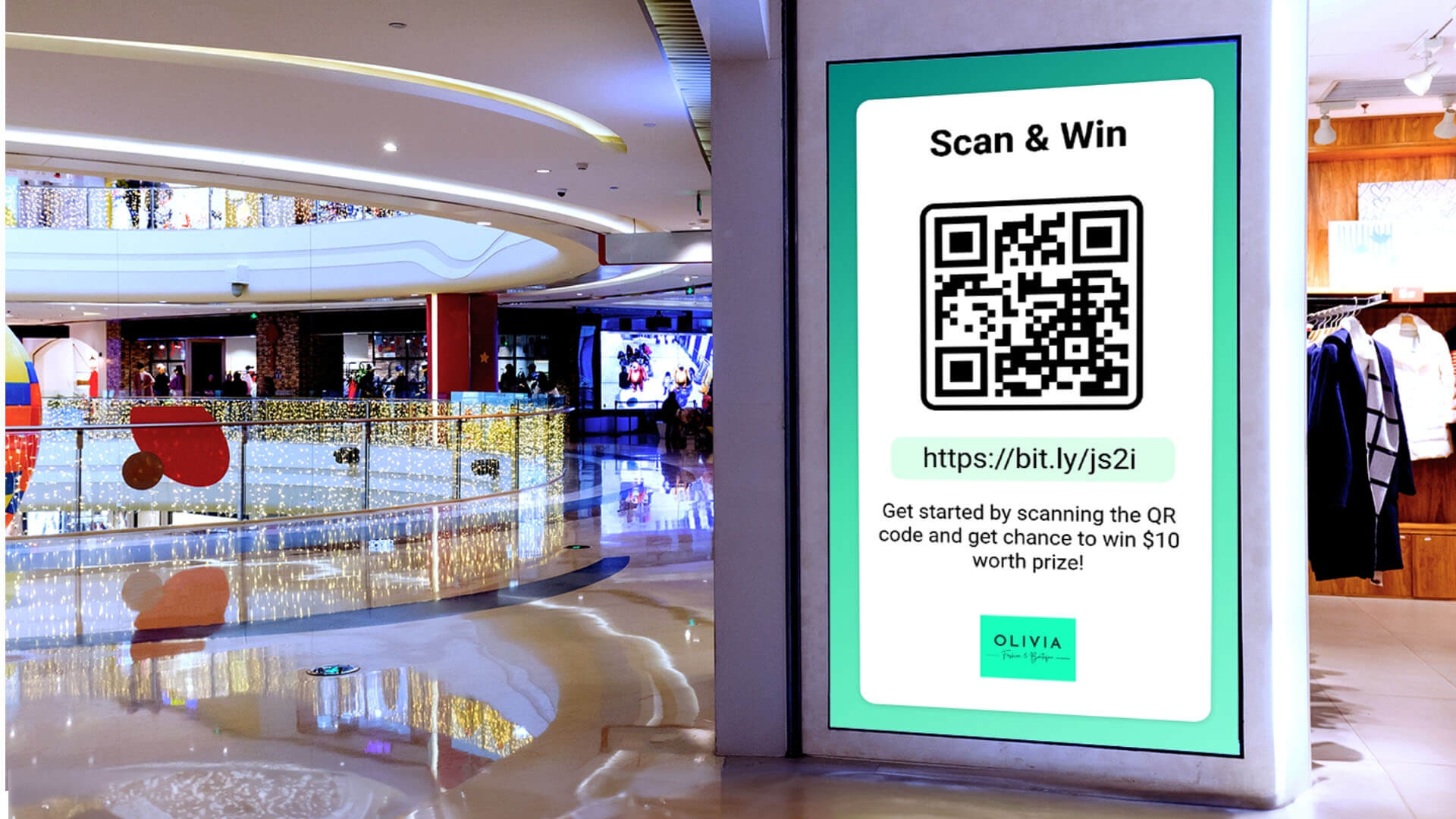
Dec 21 2023
8 min read


Dec
78% of consumers believe signage reflects the quality of a business. What this tells us is: consumers don’t see digital signage as mere displays. They consider them a powerful determinant of credibility, trust, and the perceived value of products or services.
But when given a choice between digital and static signage — which one is the right pick?
To help navigate this dilemma, we’ve done the extra homework to help you figure out which type of signage is right for your business. Let’s dive in.
Digital signage — sometimes called electronic signage — is used to display a wide range of content formats. This could include videos, images, text, and even interactive content. You can also use it to communicate with customers, promote products and provide information like event information, wayfinding and other real-time updates.
With consumers being constantly bombarded with information, grabbing their attention is difficult. This is where digital signage helps. Its ability to display dynamic content makes it more engaging than its static counterpart.
Many digital signage also come with sensors that let you analyze customer behavior so you can tailor content based on audience demographics and engagement patterns.
On the flip side, static signage follows a more traditional approach. It is generally printed on physical material like paper, vinyl, or metal. They are most often used for branding, wayfinding, and providing basic information.
When placed strategically, static signs can tap into the psychology of familiarity. This helps businesses with consistent branding and messaging, as it builds brand recall. However, for companies that want to update their messaging frequently, static signage can be quite costly and time-consuming.

While digital signage is a great option for businesses who want to engage customers by adopting a modern approach, there are a few drawbacks to this technology. Here is a list of pros and cons associated with digital signage:
With digital signage, you can quickly and conveniently change the content you want to display. This is especially useful when you want to promote new products and services, announce special events, and provide up-to-the-minute information.
Since digital signage can dynamically display content like motion graphics, scrolling text, or attention-grabbing transitions, it is a lot more engaging than static signage.
Most digital signage solutions are decked up with interactive features that let consumers engage with the displayed content. You can include elements like touchscreens or QR codes to encourage participation and make the experience more personalized and engaging.

Digital signage lets you track how many people see your content and how they interact with it. You will be able to use this data to improve your marketing strategy and measure the ROI of your investment.
You can control digital signage remotely. Whenever you want to make any updates or changes, simple click on a few buttons and voila! Job done. This flexibility is a game changer for franchises or businesses with multiple locations, as they have to ensure consistent messaging across different regions.
Digital signage can be integrated with data sources to display real-time information, like social media feeds, weather updates, or live news. This integration adds a layer of relevance and freshness to the content, which helps improve viewer engagement.
You can rotate or display multiple messages on a single screen with digital signage. This is useful in high-traffic areas where businesses want to convey various messages without overwhelming the audience.
You will need to invest in specialized hardware like digital displays, media players and touchscreens for interactive displays. Digital signage also has ongoing costs for content creation and maintenance associated with it, which drives up the overall price point.
Digital signage systems can be complex to set up and maintain. You may need to hire a professional to help you with the installation and troubleshooting, and this adds up as labour cost.
Digital signage is not as durable as static signage. Screens can be damaged by physical impact. They are also susceptible to overheating and other technical problems.
Static signage is the go-to option for businesses with a low marketing budget. But in terms of convenience, aesthetics and visibility — it doesn’t hold a candle to digital signage. If you are thinking of investing in static signage, this list of pros and cons will come in handy:
With static signage, you normally pay for your sign plus the installation (or install yourself) and you’re done. This means the initial and ongoing costs are much lower when compared to digital signage.
You can easily set up and maintain static signage. Many users install the signs themselves, so labour costs are much lower too.
In terms of durability, static signage is a clear winner. It can withstand harsh weather conditions, especially if made from hard wearing material like plastic or metal. If you need a simple sign for your shop front that will be there, come hell or high water, a static display is more than enough.
Once static signs are created, minimal maintenance is required compared to the technical upkeep of digital signage. You won’t have to worry about software updates or connectivity issues, which makes it a relatively hassle-free option.
If flexibility is a priority for you, static signage may not be the right option. Once a static sign has been printed, you won’t be able to change the content to reflect any new products or offerings. This is very restricting for businesses that want to update their content and offerings frequently.
Since static signage can only display images and text, it isn’t very engaging to consumers. Especially when compared to the dynamic content formats that digital signage uses.
Static signs are non-interactive, which means it’s impossible to capture any consumer data using them. So, if you want to measure data on audience interactions, preferences, dwell time or responses — digital signage is your best bet.
Static signs are easily overshadowed by the dynamic visuals seen in digital signage. This means it’s harder to spot and won’t grab as many eyeballs.

Both static and digital signage have advantages and disadvantages associated with them. Static signage is cheap and reliable, while digital signage is dynamic and agile. So, which one should you choose?
The answer lies in understanding which tool best aligns with the strategic goals of your business. One thing to keep in mind: although static signage comes with lower upfront costs, the expenses can pile up if you need to update content frequently. This is when digital signage becomes a no-brainer.
If you have a larger business with lots of foot traffic, then it makes sense to invest in a more sophisticated solution like digital signage.
For an older audience that isn’t very tech savvy, static signage is the better choice.
If you have a relatively low budget, and aren’t looking to invest much in signage — static signage might be a good start. But from a long-term perspective, digital signage could lead to more cost-efficiency. This is because you can make content updates at no extra cost.
In small and confined spaces, static signs are more practical. This is because they ensure the message is absorbed without overwhelming the audience. The dynamic nature of digital displays are better suited for larger, high-traffic areas.
When it comes to picking between digital and static signage, there is no right answer. Each has its own strengths and weaknesses. But in terms of building brand recall and improving customer engagement, nothing beats digital signage.
Ultimately, you will need to consider the specific needs and goals of your business to develop a nuanced signage strategy that aligns with your brand and audience. If you’d like to know more about how you can incorporate digital signage in your business, our team at Pickcel is happy to help. Reach out to us today for a no-obligation consultation.
Take complete control of what you show on your digital signage & how you show it.
Start Free Trial Schedule My Demo
Dec 21 2023
8 min read

Dec 19 2023
6 min read

Dec 8 2023
8 min read

Dec 6 2023
5 min read